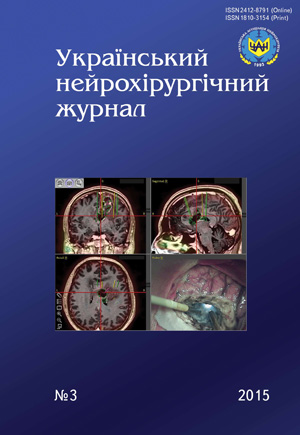Cerebellar medulloblastomas in children (age-related aspect)
DOI:
https://doi.org/10.25305/unj.50118Keywords:
medulloblastomas, surgical treatment, results, childrenAbstract
Introduction. Cerebellar medulloblastomas are high-malignant embryonic brain tumours, which are diagnosed mainly in children and characterized by early dissemination of tumors. According to the data of literature there are some features of course and results of treatment of medulloblastomas depending on age of child.
Materials and methods. The analysis of 653 supervisions of cerebellar medulloblastoma is conducted. The peaks of formation of tumours are educed in 4 years old (84 supervisions) and 7 years old (74 supervisions). All patients were operated, the diagnosis of medulloblastoma was verified histologically.
Results. A total resection of tumour was executed at 36.8% of patients, subtotal — at 52%, partial — at 11.2%. At 166 (25.4%) patients resection of tumours was complemented by the shunt operations. During 30 days after resection 49 (7.5%) patients died. A catamnesis was estimated in 488 (74.7%) children in terms from one month to 10 years. Median of survivability was 18 months. Two-year survivability is established in 42.0%, five-year in 6.0%.
Conclusions. Medulloblastomas formed 18.2% of all brain tumours in children, in the structure of embryonic tumours — 92.6%. For the children of the early age the total resection of tumours was possible in 40.3% cases, subtotal — in 42.0%. Frequency of early dissemination of tumors in the different age-related groups of children statistically does not differ with small predominance in the children of early age. Influence of volume of combined therapy requires a study in the different age-related groups of children on survivability in postoperative period.
References
1. Louis D, Ohgaki H, Wiestler O, Cavenee WK, Burger PC, Jouvet A, Scheithauer BW, Kleihues P. The 2007 WHO Classification of Tumours of the Central Nervous System. Acta Neuropathol. 2007;114(2):97-109. [CrossRef] [PubMed]
2. Matsko DE. Atlas opukholey tsentral'noy nervnoy sistemy [Atlas of tumors of the central nervous system]. St. Petersburg: RNSI; 1998. Russian.
3. Johnston D, Daniel L, Keene L, Steinbok P, Sung L, Carret AS, Crooks B, Strother D, Wilson B, Odame I, Eisenstat DD, Mpofu C, Zelcer S, Huang A, Bouffet E. Supratentorial primitive neuroectodermal tumors: a Canadian pediatric brain tumor consortium report. J. Neurooncol. 2007;86(1):101–108. [CrossRef] [PubMed]
4. N. Gerber, K. von Hoff, W. Treulieb Hyperfractionated craniospinal radiochemotherapy followed by maintenance chemotherapy in children older than 4 years with supratentorial primitive neuroectodermal tumor (STPNET). In: SIOP Abstract Book, 40th Congress of the SIOP;2008 Oct. 2-6; Berlin, 2008. p.46.
5. Kumirova EV. Embrional'nyye opukholi tsentral'noy nervnoy sistemy u detey: optimizatsiya lecheniya i rezul'taty [Embryonic tumors of the central nervous system in children: optimization of treatment and results] [dissertation]. Moskva [Russia]: Federal Scientific and Clinical Center of Pediatric Hematology, Oncology and Immunology; 2010. Russian.
6. Orlov YuA, Shaversky AV. Medulloblastomy mozzhechka u detey: rezul'taty lecheniya i prognosticheskiye factory [Cerebellar medulloblastoma in children: outcome and prognostic factors]. In: Abstract Book of IV Congress of Neurosurgeons of Ukraine; 2008 May 27-30; Dnepropetrovsk, Ukraine. Dnepropetrovsk, 2008. p.135. Russian.
7. Shaversky AV. Pukhlyny holovnoho mozku u ditey molodshoho viku [Brain tumors in young children] [dissertation]. Kiev (Ukraine): Romodanov Neurosurgery Institute; 2014. Ukrainian.
8. Chan MY, Teo WY, Seow WT, Tan AM. Epidemiology management and treatment outcome of medulloblastoma Singapore. Ann. Acad. Med. Singapore. 2007;36(5):314-318. [PubMed]
9. Rutkowski S. Chemotherapeutic strategies for young children with brain tumors. In: SIOP Abstract Book, 40th Congress of the SIOP; 2008 Oct. 2-6; Berlin — Berlin, 2008. p.7.
10. Chang C, Housepian E, Herbert C. An operative staging system and a megavoltage radiotherapeutic technique for cerebellar medulloblastoma. Radiology. 1969;93(6):1351-1359. [CrossRef] [PubMed]
11. Shaversky AV, Orlov YuA, Mikhaylyuk VS. Dyahnostyka y lechenye medulloblastom mozzhechka u detey [Diagnosis and Treatment of Cerebellar Medulloblastoma in Children]. Collection of Scientific Works of Staff Members of P.L. Shupyk NMAPE . 2013;22(3):34-41. Ukrainian.
Downloads
Published
How to Cite
Issue
Section
License
Copyright (c) 2015 Yuriy Orlov, Andrii Shaverskyi, Viktor Morgun, Leonid Marushchenko

This work is licensed under a Creative Commons Attribution 4.0 International License.
Ukrainian Neurosurgical Journal abides by the CREATIVE COMMONS copyright rights and permissions for open access journals.
Authors, who are published in this Journal, agree to the following conditions:
1. The authors reserve the right to authorship of the work and pass the first publication right of this work to the Journal under the terms of Creative Commons Attribution License, which allows others to freely distribute the published research with the obligatory reference to the authors of the original work and the first publication of the work in this Journal.
2. The authors have the right to conclude separate supplement agreements that relate to non-exclusive work distribution in the form of which it has been published by the Journal (for example, to upload the work to the online storage of the Journal or publish it as part of a monograph), provided that the reference to the first publication of the work in this Journal is included.









